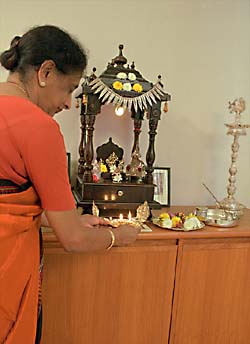|
Chapter 2: Background Information for Teachers |
|
||||||||||||
|
The heart of every Hindu home is its shrine: the sacred space set apart for honoring and worshiping the gods. While a particularly devout Hindu may visit a temple every day, others go there only to request a favor of the deity, to fulfill specific vows, or on festival days. The pujas that take place in the household shrine are the foundation of all family actions and decisions. Temple worship requires the intervention of a priest, but in the home the contact between devotee and deity is direct. The size and decoration of a household shrine do not matter. The shrine may be large and impressive, an entire room or a beautifully designed edifice, or it may be simply a tiny niche, or even just a row of religious prints pasted on a wall. Although children grow up following family beliefs, they are encouraged as young adults to make their own choices of which gods or goddesses they find personally inspiring. Consequently, household shrines contain images of deities that pertain to the belief systems of all a home's inhabitants, and it is not uncommon to find several small individual shrines in one household. Puja is usually performed by at least one member of the household every day. Puja is a means of honoring the gods or goddesses, whose presence in the home is believed to protect the family and to engender good fortune. The paraphernalia used include an incense burner and a tray with flowers, fruits, and food. |
||||||||||||
|
Case Study: Worship at a Household Shrine The shrine in the photograph on the left is typical of one that might be found in a middle-class Hindu home. Members of the family choose objects specific to their devotion to place in the shrine. Many objects are handed down through generations, while others may be purchased during a pilgrimage or commissioned from a craftsperson in response to a special need. As a part of daily puja, the deities' presence is honored by washing each sculpture with water and other sacred substances, dressing it, and adorning it with flowers and powdered vermilion, a red dye. During worship, each devotee gives to the gods offerings of more flowers and fruit. | |||||||||||||
|
|
|||||||||||||
